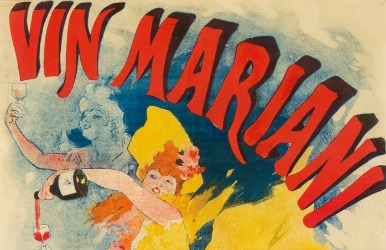When Did They Stop Putting Lead In Paint

Melissa Hillier/Flickr
Some died slow deaths. Others went into convulsions. Tens of thousands even so to be born were at chance of permanent damage.
Lead paint initially seemed harmless. The lead pigment that lent color and texture to the oil that formed its base made up equally much every bit 70 percent of a can of paint. Every bit lilliputian equally a thumbnail-sized chip, though, could send kids into convulsions. Simply that didn't hateful anyone was doing annihilation. And at that place was a reason.
Since the 1920s, the lead industry had organized to fight bans, restrictions, even warnings on paint-tin labels. It had marketed the mortiferous production to children and parents, spreading the lie that lead paint was condom. For decades, paint ads appeared in the Sat Evening Post, Skillful Housekeeping, National Geographic, and other national magazines and local newspapers. Coloring books were handed out to children. The manufacture even sent Dutch Boy costumes to children on Halloween, and printed coloring books that showed children how to prepare it.
When public health officials in New York, Baltimore, and Chicago tried to enact regulations in the 1950s that threatened the manufacture's interests, lobbyists visited legislators and governors to get restrictions lifted. They succeeded. When Baltimore'south health department called for the removal of lead from paint, the industry countered by proposing and winning a "voluntary" standard, reducing the atomic number 82 content in paint. When New York City's health department proposed a warning characterization maxim that the product was poisonous to children, the industry rejected the "poison" label and lobbied successfully for another label that just brash parents not to use it on "toys, article of furniture, or interior surfaces that might be chewed by children," and deliberately avoided mentioning that lead paint was poisonous. It hired public relations firms to program out strategies to forestall threats to the pb market.
The lead manufacture even sought to identify the blame for lead poisoning epidemic on parents and children, claiming that the trouble was not with the lead paint merely with the "uneducable Negro and Puerto Rican" parents who "failed" to stop children from placing their fingers and toys in their mouths. Children poisoned by atomic number 82, the industry claimed, had a disease that led them to suck on "unnatural objects" and thereby get poisoned.
Simply the industry wouldn't remove all lead from their products. It fought every attempt at regulation. Industry representatives threatened lawsuits against television stations such as CBS that aired popular shows like Highway Patrol in which the production was depicted every bit unsafe ... All this despite records that show that the manufacture knew that their product was poisoning children.
Does this playbook sound familiar? To anyone who has been following the furious efforts of the soda industry to counter public health initiatives to limit consumption of their product, it should. As information technology should to anyone familiar with the history of the tobacco industry's efforts to deny the obvious. Equally with all such comparisons when it comes to the food manufacture, an initial caveat is essential: lead and tobacco were known to be lethal.
But in all these cases, industry presents the problem only as a matter of choice and then blames consumers for non taking simple precautions to protect themselves: smokers who don't quit; parents who don't supervise their children and "let" them eat lead paint; people who simply have no thought of moderation or the importance of physical action.
In the instance of lead paint, subsequently 3 decades of industry lobbying, propaganda, and denial of danger, local wellness departments began to affirm themselves. In 1949, Maryland's House of Delegates passed a bill banning the employ of atomic number 82 paint on children's toys and furniture -- a law that was repealed nether industry force per unit area the following year. A few years later, the City of Baltimore health department required a warning characterization be placed on paint cans. Then, in 1959, the New York City Board of Health prohibited the employ of pigment containing more than one percent atomic number 82 on interior surfaces.
Other major cities followed conform. Slowly, the number of children facing brain impairment began to decline. In 1971, the federal government banned lead-based paints on public housing. Finally, in 1978, nearly ii decades after the actions of local departments of health, the federal authorities banned the use of atomic number 82 in near whatever pigment intended for auction to consumers.
In recent years, New York City'south Lath of Wellness has tried to stem the obesity epidemic. New York became the outset urban center in the nation to require that calorie counts accompany food items in fast nutrient restaurants. And, of course, the Board of Health recently tried to limit the size of soda servings.
Equally with the earlier attempts to regulate atomic number 82 paint, the affected industries accept combined in a furious campaign that has transformed the public's understanding of the city's efforts.
Soda manufacturers, restaurants, movie chain operators, and their allies accept tried to convince us that this effort is an set on on our personal freedom: on billboards and signs the industry proclaims that we should non let authorities "bureaucrats" tell us how much nosotros can drink. Farther, the manufacture has worked its hardest to introduce doubt over the link between obesity, diabetes, and the amount of sugar consumed, arguing that there is meaning scientific doubt and controversy. Finally, the industry has argued that the soda industry and certain types of stores are being "unfairly" singled out.
Supreme Court Justice Milton Tingling accepted much of the industry's argument, arguing that the Board of Wellness did non have the authority to limit sugary drink container sizes and that the ban was "arbitrary" and "capricious" because not all stores were included in the ban. But the New York Metropolis Board of Health is firmly established in the City Charter with the specific part of protecting the City's residents from all health threats -- not only infectious ones.
Recommended

Demanding that all scientific questions exist answered and all aspects of a rule exist completely consistent before regulations are put in place is a frightening requirement -- one that, if upheld, would put an end to most public health activities. Every bit with lead poisoning, obesity is an issue that is generating hundreds of studies, and will keep generating them in the coming years. If we take to await for scientists to attain a consensus most all aspects of the obesity epidemic and other chronic affliction threats, we will find our public health departments paralyzed and our wellness threatened. Information technology is the responsibility of public health departments to protect us from health dangers, regardless of the biological mechanism.
We still have children suffering from pb's effects, just at least kids no longer convulse and dice. If the New York City Board of Wellness had not banned the sale of lead paint in 1959, we would take experienced more generations of children with lead-acquired severe brain damage. Whatever the legal niceties are regarding "what is an epidemic," the reality is that nosotros will be sacrificing a generation of children to the consequences of obesity if wellness agencies don't begin to take action.
Source: https://www.theatlantic.com/health/archive/2013/04/why-it-took-decades-of-blaming-parents-before-we-banned-lead-paint/275169/
Posted by: granadosguried.blogspot.com


0 Response to "When Did They Stop Putting Lead In Paint"
Post a Comment